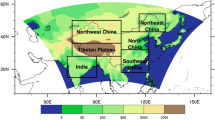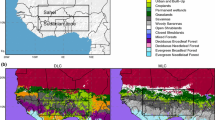Abstract
A simplified vegetation distribution prediction scheme is used in combination with the Biosphere-Atmosphere Transfer Scheme (BATS) and coupled to a version of the NCAR Community Climate Model (CCM1) which includes a mixed-layer ocean. Employed in an off-line mode as a diagnostic tool, the scheme predicts a slightly darker and slightly rougher continental surface than when BATS' prescribed vegetation classes are used. The impact of tropical deforestation on regional climates, and hence on diagnosed vegetation, differs between South America and S.E. Asia. In the Amazon, the climatic effects of removing all the tropical forest are so marked that in only one of the 18 deforested grid elements could the new climate sustain tropical forest vegetation whereas in S.E. Asia in seven of the 9 deforested elements the climate could continue to support tropical forest. Following these off-line tests, the simple vegetation scheme has been coupled to the GCM as an interactive (or two-way) submodel for a test integration lasting 5.6 yr. It is found to be a stable component of the global climate system, producing only ~ 3% (absolute) interannual changes in the predicted percentages of continental vegetation, together with globally-averaged continental temperature increases of up to + 1.5 °C and evaporation increases of 0 to 5 W m−2 and no discernible trends over the 67 months of integration. On the other hand, this interactive land biosphere causes regional-scale temperature differences of ± 10 °C and commensurate disturbances in other climatic parameters. Tuning, similar to the q-flux schemes used for ocean models, could improve the simulation of the present-day surface climate but, in the longer term, it will be important to focus on predicting the characteristics of the continental surface rather than simple vegetation classes. The coupling scheme will also have to allow for vegetation responses occurring over longer timescales so that the coupled system is buffered from sudden shocks.
Similar content being viewed by others
References
Box, E.: 1978, ‘Ecoclimatic Determination of Terrestrial Vegetation Physiognomy’, PhD Dissertation, University of North Carolina, Chapel Hill, 381 pp.
Charney, J. G.: 1975, ‘Dynamics of Deserts and Drought in the Sahel’,Quart. J. Roy. Meteor. Soc. 101, 193–202.
Charney, J. G., Quirk, W. J., Chew, S. M., and Kornfield, J.: 1977, ‘Dynamics of Deserts and Droughts in the Sahel’,J. Atmos. Sci. 34, 1366–1388.
Cubasch, U.: 1989, ‘A Global Coupled Atmosphere-Ocean Model’,Phil. Trans. Roy. Soc. (Ser A) 329, 263–273.
Dickinson, R. E.: 1984, ‘Modeling Evapotranspiration for Three-Dimensional Global Climate Models’, inClimate Processes and Climate Sensitivity, Geophysical Monograph 29, Maurice Ewing Volume 5, 58-72.
Dickinson, R. E.: 1988, ‘The Force-Restore Model for Surface Temperature and Its Generalizations’,J. Clim 1, 1086–1097.
Dickinson, R. E. and Henderson-Sellers, A.: 1988, ‘Modelling Tropical Deforestation: A Study of GCM Land-Surface Parameterizations’,Quart. J. Roy. Meteor. Soc. 114(B, 439–462.
Dickinson, R. E., Henderson-Sellers, A., Kennedy, P. J., and Wilson, M. F.: 1986, ‘Biosphere-Atmosphere Transfer Scheme (BATS) for the NCAR Community Climate Model’, NCAR Tech. Note, NCAR/TN-275 + STR, Boulder, CO, 69 pp.
Dickinson, R. E., Henderson-Sellers, A., Kennedy, P. J., and Giorgi, F.: 1992, ‘Biosphere-Atmosphere Transfer Scheme (BATS), Version 1e as Coupled to the NCAR Community Climate Model’, NCAR Technical Note, in preparation.
Dorman, J. L. and Sellers, P. J.: 1989, ‘A Global Climatology of Albedo, Roughness Length and Stomatal Resistance for Atmospheric General Circulation Models as Represented by the Simple Biosphere model (SiB)’,J. Appl. Meteor. 28, 833–855.
Emanuel, W. R., Shugart, H. H., and Stevenson, M. P.: 1985a, ‘Climatic Change and the Broad-Scale Distribution of Terrestrial Ecosystem Complexes’,Clim. Change 7, 29–44.
Emanuel, W. R., Shugart, H. H., and Stevenson, M. P.: 1985b, ‘Response to Rowntree’,Clim. Change 7, 457–460.
Henderson-Sellers, A.: 1990a, ‘Predicting Generalized Ecotype Groups with the NCAR CCM: First Steps towards an Interactive Biosphere’,J. Clim. 3, 917–940.
Henderson-Sellers, A.: 1990b, ‘Getting GARP to Grow Grass: Land Surfaces in Global Climate Models’, Fourth R. H. Clarke lecture,Aust. Meteor. Mag. 38, 245–254.
Henderson-Sellers, A.: 1992, ‘Factorial Experiments Identify Critical Factors for Climate Modelling of Tundra’,Geophys. Res. Letters (in press).
Henderson-Sellers, A., and Gornitz, V.: 1984, ‘Possible Climatic Impacts of Land Cover Transformations, with Particular Emphasis on Tropical Deforestation’,Climatic Change 6, 231–258.
Henderson-Sellers, A., Durbidge, T. B., Pitman, A. J., Dickinson, R. E., Kennedy, P. J., and McGuffie, K.: 1993, ‘Tropical Deforestation: Modelling Local to Regional-Scale Climate Change’,J. Geophys. Res. (in press).
Holdridge, L. R.: 1947, ‘Determination of World Plant Formations from Simple Climatic Data’,Science 105, 367–368.
Holdridge, L. R.: 1964,Life Zone Ecology, Tropical Science Center, San José, Costa Rica.
Houghton, R. A. and Skole, D. L.: 1990, ‘Carbon’, in Turner, B. L., Clark, W. C., Kates, R. W., Richards, J. F., Mathews, J. T., and Meyer, W. B. (eds.),The Earth as Transformed by Human Action, Cambridge University Press, 393-408.
Houghton, R. A., Hobbie, J. E., Melillo, J. M., Moore, B., Peterson, B. J., Shaver, G. R., and Woodwell, G. M.: 1983, ‘Changes in the Carbon Content of Terrestrial Biota and Soils between 1860 and 1980: A Net Release of CO2 to the Atmosphere’,Ecological Monographs 53(3, 235–262.
IGBP: 1990, ‘The International Geosphere-Biosphere Programme: A Study of Global Change, The Initial Core Projects’, Report No. 12, IGBP, Stockholm.
Köppen, W.: 1900, ‘Versuch einer Klassification der Klimate, vorzurgsweise nach Ihren Beziehungen zur Pflanzenwelt’,Geogr. Z. 6, 593–611, 657-679.
Lean, J. and Warrilow, D. A.: 1989, ‘Simulation of the Regional Climatic Impact of Amazon Deforestation’,Nature 342, 411–413.
Legates, D. R. and Willmott, C. J.: 1990a, ‘Mean Seasonal and Spatial Variability in Gauge-Corrected, Global Precipitation’,Int. J. Climatol. 10, 111–127.
Legates, D. R. and Willmott, C. J.: 1990b, ‘Mean Seasonal and Spatial Variability in Global Surface Air Temperature’,Theor. Appl. Climatol. 41, 11–21.
Manabe, S. and Bryan, K.: 1985, ‘CO2-Induced Change in a Coupled Ocean-Atmosphere Model and Its Paleoclimatic Implications’,J. Geophys. Res. 90, 11689–11707.
Matthews, E.: 1983, ‘Global Vegetation and Land Use: New High Resolution Databases for Climate Studies’,J. Clim. Appl. Meteor. 22, 474–487.
Meehl, G. A. and Washington, W. M.: 1988, ‘A Comparison of Soil-Moisture Sensitivity in Two Global Climate Models’,J. Atmos. Sci. 45, 1476–1492.
Meehl, G. A., Washington, W. M., and Karl, T. R.: 1992, ‘Low-Frequency Variability and CO2 Transient Climate Change, Part 1: Time Averaged Differences’,Clim. Dynam. (in press).
Olson, J. S., Watts, J. A., and Allison, L. J.P: 1983, ‘Carbon in Live Vegetation of Major World Ecosystems’, DOE/NBB Report Number TR004, Oak Ridge National Laboratory, Oak Ridge, TN 37830, 152 pp.
Pitman, A. J., Henderson-Sellers, A., and Yang, Z.-L.: 1990, ‘Sensitivity of Regional Climates to Localized Precipitation in Global Models’,Nature 346, 734–737.
Prentice, K. C.: 1990, ‘Bioclimatic Distribution of Vegetation for General Circulation Model Studies’,J. Geophys. Res. 95, 11,811–11,830.
Shukla, J. and Mintz, Y.: 1982, ‘Influence of Land-Surface Evapotranspiration on the Earth's Climate’,Science 215, 1498–1501.
Shukla, J., Nobre, C.A., and Sellers, P.J.: 1990, ‘Amazonia Deforestation and Climate Change’,Science 247, 1322–1325.
Slingo, A.: 1989, ‘A GCM Parameterization for the Shortwave Radiative Properties of Water Clouds’,J. Atmos. Sci. 46, 1419–1427.
Sud, Y. C., Shukla, J., and Mintz, Y.: 1988, ‘Influence of Land Surface Roughness on Atmospheric Circulation and Precipitation: A Sensitivity Study with a General Circulation Model’,J. Appl. Meteor. 27, 1036–1054.
Thornthwaite, C. W.: 1933, ‘The Climates of the Earth’,Geogr. Rev. 23, 433–440.
Washington, W. M. and Meehl, G. A.: 1984, ‘Seasonal Cycle Experiment on the Climate Sensitivity due to a Doubling of CO2 with an Atmospheric General Circulation Model Coupled to a Simple Mixed-Layer Ocean Model’,J. Geophys. Res. 89, 9475–9503.
Washington, W. M. and Meehl, G. A.: 1989, ‘Climate Sensitivity Due to Increased CO2 Experiments with a Coupled Atmosphere and Ocean General Circulation Model’,Clim. Dynam. 4, 1–38.
Williamson, G. S. and Williamson, D. L.: 1987, ‘Circulation Statistics from Seasonal and Perpetual January and July Simulations with the NCAR Community Climate Model (CCM1): R15’, National Center for Atmospheric Research, Technical Note, NCAR/TN-302+STR, 199 pp.
Williamson, D. L., Kiehl, J. T., Ramanathan, V., Dickinson, R. E., and Hack, J. J.: 1987, ‘Description of NCAR Community Climate Model (CCM1)’, NCAR Tech. Note NCAR/TN-285+STR, National Center for Atmospheric Research, Boulder, CO, 112 pp.
Wilson, M. F. and Henderson-Sellers, A.: 1985, ‘A Global Archive of Land Cover and Soils Data for Use in General Circulation Climate Models’,J. Clim. 5, 119–143.
Wilson, M. F., Henderson-Sellers, A., Dickinson, R. E., and Kennedy, P. J.: 1987a, ‘Investigation of the Sensitivity of the Land-Surface Parameterization of the NCAR Community Climate Model in Regions of Tundra Vegetation’,J. Clim. 7, 319–343.
Wilson, M. F., Henderson-Sellers, A., Dickinson, R. E., and Kennedy, P. J.: 1987b, ‘Sensitivity of the Biosphere-Atmosphere Transfer Scheme (BATS) to the Inclusion of Variable Soil Characteristics’,J. Clim. Appl. Meteor. 26, 341–362.
Woodward, F. I.: 1987,Climate and Plant Distribution, Cambridge Studies in Ecology, Cambridge University Press, Cambridge, 174 pp.
Author information
Authors and Affiliations
Rights and permissions
About this article
Cite this article
Henderson-Sellers, A. Continental vegetation as a dynamic component of a global climate model: a preliminary assessment. Climatic Change 23, 337–377 (1993). https://doi.org/10.1007/BF01091622
Received:
Revised:
Issue Date:
DOI: https://doi.org/10.1007/BF01091622




